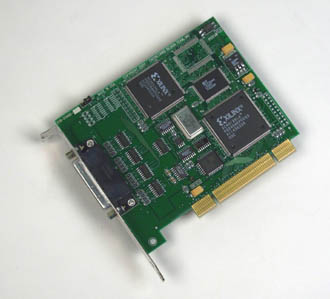DVC / LVDS frame grabber for PCI
This product has been discontinued, and is no longer supported. The information on this page is provided for reference only.
Features
- Single PCI local bus slot
- Interfaces DVC Co. digital cameras and other AIA Monochrome and color digital cameras to PCI Local Bus Computers
- 3-row 44-pin D connector optimal for 44-pin cameras and devices
- Supports 8 through 16 bit resolution
- Direct memory access to host memory — camera resolution independent
- PCI Local Bus data rates up to maximum supported by host
- 33 Mhz, 32-bit PCI board
- Supports AIA serial command interface over RS-422 and 232 serial lines
- Device drivers & SDK for Windows™ and Linux.
>Description
The PCI DV44 provides high-resolution image capture for DVC Co. cameras and other EIA-644 (LVDS) single and dual channel cameras. Spatial and depth resolution and the number of buffers are limited only by the host memory. Images can be captured and displayed in real-time. The PCI DV44 is similar to the PCI DVK, the primary difference being the connector.
>Cameras Supported
The PCI DV44’s 44-pin connector makes it the best choice for cameras with standard 44-pin cables/connectors, such as the DVC 1300 & 1400 series cameras. Most AIA monochrome and color, Category 1, extended single and dual channel digital cameras are also supportable, but may require a custom cable. In general, the PCI DV or PCI DVa, (80-pin connector) or PCI DVK (68-pin SCSI 2 connector) would be preferred for cameras that don’t use the 44-pin connector.
See Cables for more information on standard cabling.
>Software
The PCI DV44 comes with a configurable device driver, a C language interface library, example programs, and an X-Windows or MS Windows based camera control and image capture and display program (click here for screen shots). The device driver provides direct virtual memory access for the host computer, including features for controlling the device and determining its status. Example programs demonstrate this capability using the functions provided in the library. A number of third party products are available as well to provide turn-key solutions to image acquisition needs.
Applications
- Machine vision
- Manufacturing/Inspection
- Computer microscopy
- Astronomy
- Aerial mapping
- Image archiving
- Image processing and analysis
- Medical imaging
- Multimedia
- Security
Specifications
A programmable gate array is configured for a specific camera when the driver is loaded. Thirty-two LVDS signals are configured as inputs or outputs, as required by the camera. Outputs can also be configured as single-ended for TTL camera control lines. The PCI DV44 does not include frame buffer memory. Video data is stored in host memory as required by the camera and application.
Device drivers for Linux and Windows™.
The PCI DV44 is designed to be used with 44-pin to 44-pin twisted pair cables, standard for DVC Company cameras. Cables are available from EDT or your camera manufacturer. For connector pinouts, see the PCI DV Addenda: AIA Digital Camera Interface for AIA Generic
The PCI DV44 is designed to be used with 44-pin to 44-pin twisted pair cables, standard for DVC Company cameras. Cables are available from EDT or your camera manufacturer.
Physical
Single PCI Local Bus slot
Dimensions: 3.3″ x 5.87″ x 0.5″
Weight: 3.8 oz.
AMP DB44 connector (manufactured by AMP Inc., 800-522-6752)
Power
5V DC, 1 A
Environmental
Temperature:
Operating: 10° to 40° C
Nonoperating: -20° to 60° C
Heat Output: 5 W
Humidity:
Operating: 20% to 80% noncondensing @ 40° C
Nonoperating: 95% noncondensing @ 40° C
Noise
0 DB
MTBF
150,000 hours
Support
EDT provides several levels of customer support, from phone consultations to custom design of hardware or software at hourly rates. Technical support is also provided though the Technical Information section of this web site.
>Ordering
To order, contact our sales department or your distributor. Be sure to specify which cable will be needed (if any). It is usually helpful to know which camera is being interfaced to as well.

